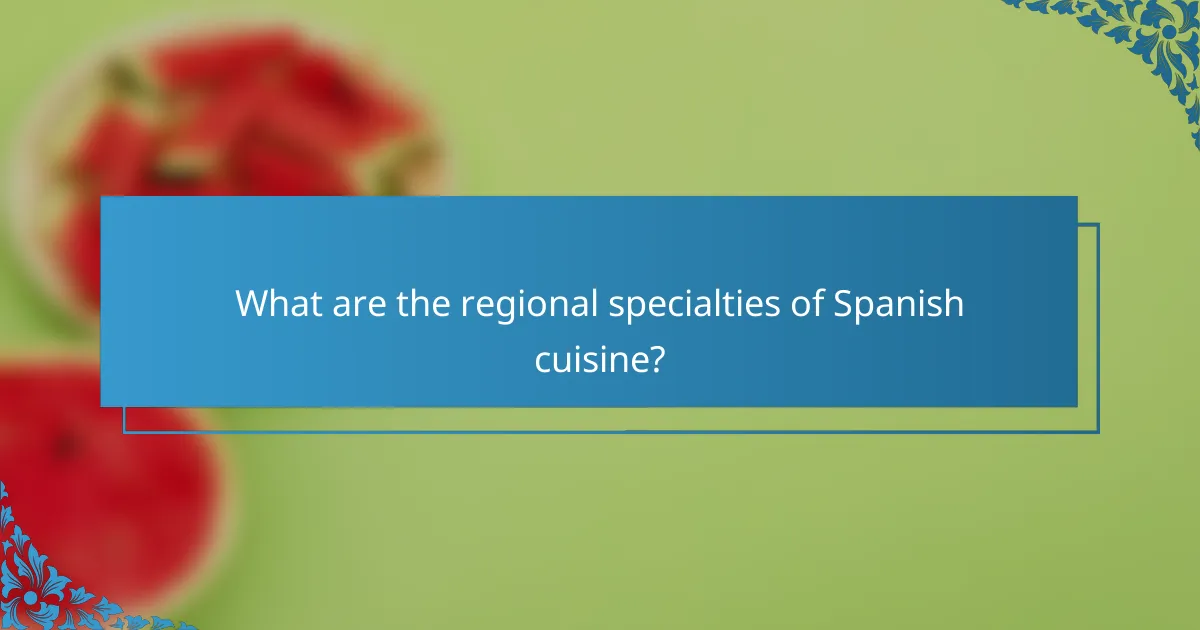Spanish cuisine is renowned for its vibrant flavors and diverse regional specialties, with tapas culture at its heart. From the bustling bars of Madrid to the culinary gems of Barcelona, tapas offer a delightful way to experience a variety of tastes, including crispy potatoes, succulent shrimp, and flavorful cured meats. Each bite reflects the rich heritage and local ingredients that define this beloved culinary tradition.

What are the best tapas in Barcelona?
The best tapas in Barcelona showcase a variety of flavors and ingredients, reflecting the city’s rich culinary heritage. Popular choices include crispy potatoes, succulent shrimp, and flavorful cured meats, each offering a unique taste of Spanish cuisine.
Patatas Bravas
Patatas bravas are a quintessential tapas dish, featuring fried potatoes served with a spicy tomato sauce or aioli. The contrast between the crispy exterior and soft interior makes them a favorite among locals and visitors alike.
When ordering patatas bravas, look for variations that include different sauces or toppings, as some restaurants may offer a twist on the traditional recipe. Pair them with a refreshing drink for a perfect snack.
Gambas al Ajillo
Gambas al ajillo consists of shrimp sautéed in olive oil with garlic and chili peppers, creating a deliciously aromatic dish. This tapas option is typically served hot and is perfect for sharing.
To enjoy gambas al ajillo, dip crusty bread into the flavorful oil left in the dish. It’s a simple yet satisfying way to savor the rich flavors of the shrimp and spices.
Jamón Ibérico
Jamón ibérico is a premium cured ham known for its rich flavor and melt-in-your-mouth texture. Sourced from black Iberian pigs, this delicacy is often served in thin slices and pairs beautifully with cheese and bread.
When sampling jamón ibérico, consider trying different varieties, such as jamón ibérico de bellota, which comes from pigs that are acorn-fed, offering an even deeper flavor profile. Enjoy it as part of a charcuterie board for a true Spanish experience.
Pan con Tomate
Pan con tomate is a simple yet flavorful dish made by rubbing ripe tomatoes on toasted bread, drizzled with olive oil and sprinkled with salt. This classic tapa highlights the quality of the ingredients used.
For a variation, some places add toppings like cured meats or cheese, enhancing the dish’s flavor. It’s an excellent choice for a light snack or appetizer before a larger meal.
Chorizo al Vino
Chorizo al vino features Spanish chorizo sausage cooked in red wine, resulting in a rich and savory dish. The combination of spices in the chorizo and the wine creates a delightful flavor that pairs well with bread.
When ordering chorizo al vino, look for establishments that use high-quality chorizo for the best experience. This dish is often served warm and makes for a hearty addition to any tapas spread.

How to experience tapas culture in Madrid?
To fully experience tapas culture in Madrid, immerse yourself in the vibrant atmosphere of local bars, participate in guided tapas tours, and explore traditional markets. These activities will introduce you to a variety of flavors and regional specialties that define this culinary tradition.
Tapas tours
Joining a tapas tour is an excellent way to discover the best local dishes while learning about their history and cultural significance. Many tours last around two to three hours and typically include visits to several bars, where you can sample a range of tapas paired with local wines or beers.
Look for tours that focus on specific neighborhoods, such as La Latina or Malasaña, to get a taste of the area’s unique offerings. Booking in advance is advisable, especially during peak tourist seasons, to secure your spot.
Local bars
Madrid is home to countless local bars, each with its own character and specialty tapas. Popular options include classic taverns where you can find traditional dishes like patatas bravas or jamón ibérico. Many bars offer a casual atmosphere, making it easy to socialize while enjoying your meal.
When visiting, consider ordering a variety of tapas to share, as this is a fundamental aspect of the tapas experience. Be mindful of peak hours, typically from 8 PM to 10 PM, when bars can become quite crowded.
Traditional markets
Exploring traditional markets is another fantastic way to experience Madrid’s tapas culture. Markets like Mercado de San Miguel and Mercado de Antón Martín feature numerous stalls offering a wide array of tapas, fresh produce, and local delicacies. These markets often have communal seating, allowing you to enjoy your food in a lively environment.
Take the time to sample different dishes from various vendors, as this will give you a broader understanding of the diverse flavors available. Visiting during weekdays can help you avoid the weekend crowds and enhance your experience.

What are the regional specialties of Spanish cuisine?
Spanish cuisine is rich in regional specialties that reflect the diverse cultures and traditions across the country. Each region offers unique dishes that highlight local ingredients and culinary techniques.
Paella from Valencia
Paella is a signature dish from Valencia, known for its vibrant colors and rich flavors. Traditionally made with rice, saffron, and a variety of proteins such as chicken, rabbit, or seafood, it is cooked in a wide, shallow pan.
When preparing paella, it’s essential to use the right type of rice, such as Bomba or Calasparra, which absorbs flavors well without becoming mushy. The cooking process typically involves layering ingredients and allowing them to simmer together, creating a socarrat, or crispy bottom layer.
Gazpacho from Andalusia
Gazpacho is a refreshing cold soup originating from Andalusia, perfect for hot summer days. Made primarily from tomatoes, cucumbers, bell peppers, onions, and garlic, it is blended with olive oil, vinegar, and bread for texture.
To make a traditional gazpacho, use ripe, in-season vegetables for the best flavor. Serve it chilled, garnished with diced vegetables or croutons. This dish is not only delicious but also a healthy option, rich in vitamins and low in calories.
Pintxos from Basque Country
Pintxos are small snacks typically served in bars throughout the Basque Country, often skewered with a toothpick. They can range from simple combinations of bread and toppings to elaborate creations featuring seafood, meats, and vegetables.
When enjoying pintxos, it’s common to sample several varieties in one sitting. Look for bars that display their pintxos prominently, allowing you to choose what looks appealing. Pair them with a glass of local wine or cider for an authentic experience.

What are the vibrant flavors of Spanish cuisine?
The vibrant flavors of Spanish cuisine are characterized by a rich blend of ingredients, techniques, and regional influences. This culinary tradition emphasizes freshness, bold tastes, and a variety of textures, making each dish a unique experience.
Use of olive oil
Olive oil is a cornerstone of Spanish cooking, often used as a base for many dishes. Extra virgin olive oil, known for its robust flavor, is preferred for dressings and drizzling over finished plates. It is not only a source of flavor but also a healthy fat, rich in antioxidants and beneficial compounds.
When selecting olive oil, look for labels indicating origin and quality, as Spanish oils from regions like Andalusia and Catalonia are particularly renowned. A good rule of thumb is to use olive oil generously in salads, marinades, and to enhance the taste of grilled vegetables or seafood.
Fresh herbs and spices
Fresh herbs and spices play a vital role in enhancing the vibrant flavors of Spanish dishes. Commonly used herbs include parsley, thyme, and rosemary, while spices like paprika and saffron add depth and warmth. Each region in Spain has its own signature herbs that reflect local tastes and traditions.
For instance, pimentón (smoked paprika) is essential in dishes like paella and chorizo, while saffron is prized for its unique flavor and color in rice dishes. Experimenting with these herbs and spices can elevate home-cooked meals and bring authentic Spanish flavors to your table.
Seasonal ingredients
Seasonal ingredients are crucial to Spanish cuisine, ensuring that dishes are fresh and flavorful. Markets across Spain showcase a variety of fruits, vegetables, and seafood that change with the seasons, encouraging cooks to adapt their menus accordingly. This practice not only supports local agriculture but also enhances the taste of the food.
For example, summer brings ripe tomatoes and peppers, perfect for gazpacho, while winter offers hearty root vegetables and legumes for stews. Embracing seasonal produce allows for creativity in cooking and a deeper connection to the local culinary landscape.

How to choose the right tapas for your meal?
Choosing the right tapas involves considering flavor profiles, regional specialties, and personal preferences. Opt for a variety of textures and tastes to create a balanced meal, ensuring a mix of meats, seafood, vegetables, and cheeses.
Pairing with beverages
Pairing tapas with beverages enhances the dining experience. Traditional choices include Spanish wines, such as Rioja or Albariño, and regional beers like Estrella Damm. Each drink complements specific tapas, elevating flavors and aromas.
For example, rich meats like chorizo pair well with red wines, while lighter seafood dishes, such as gambas al ajillo, are best enjoyed with a crisp white wine or a refreshing beer. Consider the intensity of the dish when selecting your beverage.
When in doubt, opt for a classic combination: a fruity sangria can complement a wide range of tapas, making it a versatile choice for groups. Avoid overly sweet drinks with savory dishes, as they can clash and detract from the meal’s overall enjoyment.
